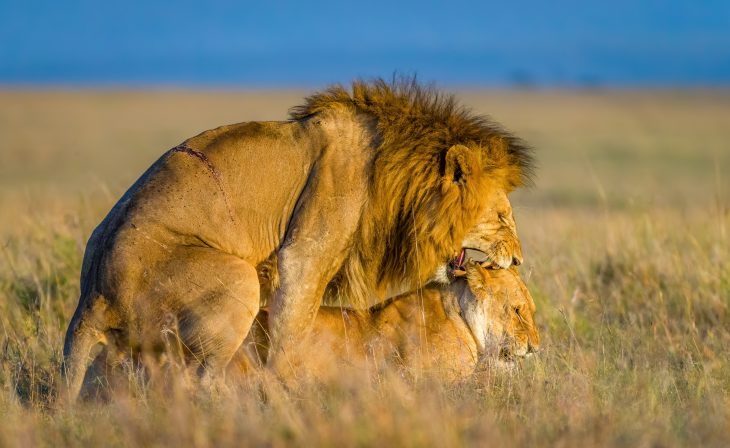
Lions, the majestic kings of the animal kingdom, captivate us with their power, beauty, and fascinating social dynamics. While we admire their hunting prowess and impressive manes, the subject of lion mating holds its own allure. In this article, we delve into 19 intriguing facts about lion mating behavior and reproductive patterns, shedding light on the wonders of the animal kingdom and offering a glimpse into the hidden world of lions.
The Social Structure of Lion Prides
Lions live in prides, which are social groups consisting of multiple related females, their cubs, and a few resident males. These prides are vital in understanding lion mating dynamics.
The Role of Lionesses in Mating
Unlike many other species, lionesses are the primary hunters of the pride. This unique attribute allows them to provide for their offspring and establishes a crucial role in attracting potential mates.
Lion Mating Rituals
When a lioness is receptive to mating, she may initiate the ritual by rubbing her head against a male’s face, an act known as “head rubbing.” This gesture strengthens the bond between potential mates.
The Importance of Territory
Lion prides maintain territories, which are defended from other prides. Mating within their territory ensures the survival of their offspring by minimizing conflicts and competition.
The Dominance of Male Lions
Male lions are the dominant members of the pride, securing mating rights through competition and physical strength. They protect the pride, fathering the cubs and passing on their genes to the next generation.
The Roaring Courtship Display
Male lions use their powerful roar as a form of courtship display. Roaring not only showcases their dominance but also alerts potential mates to their presence and readiness to mate.
Seasonal Patterns of Mating
Lions do not have a specific mating season. Instead, their reproductive patterns are influenced by factors such as food availability and female hormonal cycles, leading to a relatively continuous mating cycle.
The “Sneaky” Lion Strategy
In some cases, younger or less dominant males adopt a “sneaky” strategy to mate. They may attempt to copulate with a receptive female while the dominant male is momentarily distracted.
The Duration of Lion Mating
Lion mating encounters are relatively brief, lasting only a few seconds to a minute. This quick process reduces the risk of intruders interrupting the mating pair and allows them to focus on other essential activities.
Multiple Mating Partners
A lioness in estrus may mate with multiple males within a short period. This behavior encourages genetic diversity within the pride and creates uncertainty regarding the paternity of cubs.

The Frequency of Mating
During a female’s receptive period, known as estrus, she may engage in mating multiple times a day. This frequent mating maximizes the chances of successful fertilization.
Induced Ovulation
Lionesses experience induced ovulation, meaning that ovulation is triggered by mating. This mechanism ensures that the lioness is most fertile when mating occurs, increasing the likelihood of successful reproduction.
The Mating Monopoly of Male Lions
While lionesses mate with multiple males, dominant male lions restrict mating access to females within the pride. By doing so, they increase their chances of fathering the cubs.
The Absence of a Mating Plug
Unlike some other feline species, lions do not have a mating plug. This absence allows subsequent males to mate with a lioness soon after a previous male, potentially influencing the paternity of the cubs.
The Absence of a Menstrual Cycle
Female lions lack a menstrual cycle, making it challenging to determine their fertility status visually. Their reproductive cycles are regulated by hormonal changes and external factors.
Cubs and the Mating Hierarchy
When a new dominant male takes over a pride, he may kill the existing cubs. This act triggers the lionesses to enter estrus again, enabling the new male to reproduce and pass on his genetic legacy.
Lioness Reproductive Suppression
Lionesses possess the unique ability to suppress their own reproductive cycles when environmental conditions are unfavorable or when the pride is already producing sufficient offspring.
The Cubs’ Journey to Maturity
Lion cubs undergo a journey to adulthood, during which they gradually acquire the skills and attributes necessary for survival. Mating behaviors observed within the pride contribute to their overall development.
The Continuity of Life: A Circle of Mating
The mating rituals and behaviors of lions represent the continuity of life, ensuring the survival and success of the species for generations to come. Understanding these dynamics enriches our appreciation of the natural world and the intricate connections within it.
Conclusion
Lion mating is a fascinating subject that sheds light on the intricate social structures and behaviors within prides. From dominance displays and frequent mating to induced ovulation and the role of cubs, lions exemplify the complexity of reproductive strategies in the animal kingdom. Exploring these 19 facts has offered a glimpse into the captivating world of lion mating, inviting us to marvel at the wonders of nature.
Frequently Asked Questions (FAQs)
How long does lion mating last?
Lion mating encounters are relatively brief, typically lasting only a few seconds to a minute.
Do male lions kill cubs from previous males?
Yes, when a new dominant male takes over a pride, he may kill the existing cubs to trigger the lionesses’ estrus cycle again.
Can a lioness mate with multiple males?
Yes, during their receptive period, lionesses may mate with multiple males within a short period.
How often do lionesses mate?
Lionesses may engage in mating multiple times a day during their receptive period, known as estrus.
Do lions have a specific mating season?
Lions do not have a specific mating season. Their reproductive patterns are influenced by factors such as food availability and female hormonal cycles.
Was this page helpful?
Our commitment to delivering trustworthy and engaging content is at the heart of what we do. Each fact on our site is contributed by real users like you, bringing a wealth of diverse insights and information. To ensure the highest standards of accuracy and reliability, our dedicated editors meticulously review each submission. This process guarantees that the facts we share are not only fascinating but also credible. Trust in our commitment to quality and authenticity as you explore and learn with us.


